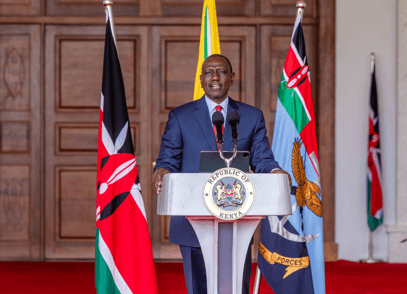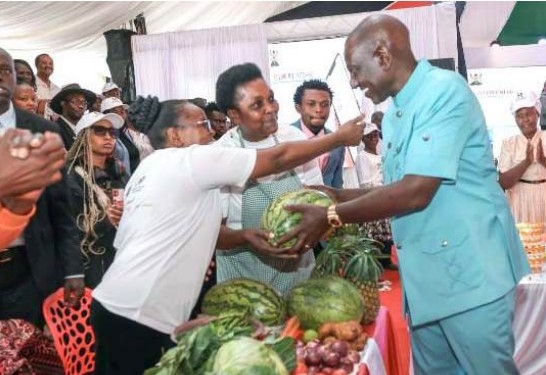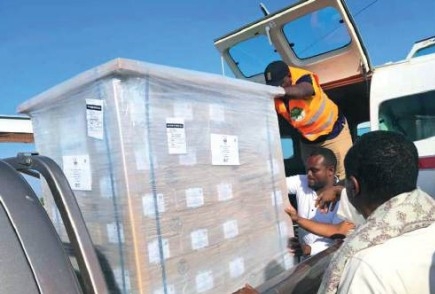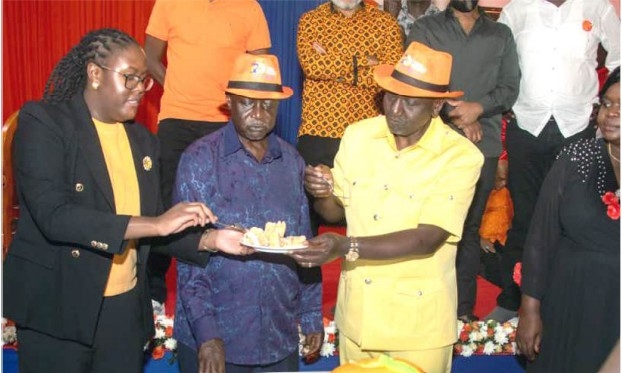With climate change threatening human existence, as the rainfall diminishes, pastoralists in Kenya are finding it difficult to sustain their stocks.
A fodder expert from China, Jack Liu, says annual fodder demand has hit 450 million metric tonnes, which requires more than three million acres of grass to satisfy demand.
In an interview with the Star, Liu said he is on a mission to end the fodder shortage in the country and increase milk yields for dairy farmers.
Liu, CEO of Crevation International Limited arrived in Kenya in 2021 and introduced a Chinese magic grass called juncao, which is also commonly known as jambo grass at his model farm near Kitengela.
Before coming to the country, Liu had done a lot of research on fodder demand in the country and how farmers struggle to feed their stocks with quality grass.
He says juncao is multi-functional as it controls desertification, degradation control, soil erosion control, livestock feeds and biodiversity and copes with climate change.
“Juncao grass is free of pests, non-invasive, sustainable, reliable and can sort desertification and soil control. It has a crude protein of 18.6 per cent,” Liu said.
The grass, he said, yields 180 metric tonnes of fodder per acre which is rich in micro elements.
Liu recommends that feedlot rearing is the trend for the sake of vegetation protection.
He is planning to plant juncao grass plantation in 24 arid and semi-arid counties across the country.
“We are planning to grow about 20,000 acres in Kajiado, 80,000 acres in Turkana, and 30,000 acres in Mandera, West Pokot, Garissa, Narok, and Wajir,” Liu said.
The investor also plans to plant at least 5,000 acres in 20 non-Asal counties that include Nakuru, Transmara, Kakamega, Embu, Migori, Kisii and Bungoma.
The investor said the Chinese jambo grass on one acre is able to sufficiently feed 20 cows.
“The grass can also be fed to chicken, fish, goats, and pigs. The cows and goats that consume the grass produce a lot of milk,” he said.
Juncao grass looks like the local napier grass but its leaves are softer and takes 3 months to grow to maturity for harvesting.
Edwin Wekesa, Liu’s manager at Kambi Ya Moto farm in Rongai, Nakuru says the demo farm was established in 2022.
The farm has now become a demo and learning site where companies, organisations, and institutions are coming to learn about the grass, said Wekesa.
According to the Kenya Agriculture and Livestock Research Organisation (KALRO), only 10 per cent of farming is devoted to fodder cultivation in Kenya, leading to a fodder shortage.
Another concern is the unavailability of good-quality fodder seeds.
Data from the National Drought Management Authority (NDMA) indicates that the country lost more than three million herds of cattle due to the prolonged drought in arid and semi-arid counties.
The situation was so dire that the national and county governments in affected regions had to intervene by providing free pasture, whose availability was also a challenge.
‘‘It is this gap that inspired me to venture into animal feeds. The recent drought situation has affected the majority of Arid and Semi-Arid Areas, where many pastoralists have lost their livestock,’’ Liu said.
‘‘When the grass is ready for harvest, processing, and packaging as silage, it would come in handy to save the situation since it can be reserved for two to three years when packaged,’’ he added during a visit to the farm recently.
It’s not just drought that the grass intends to save, but also helps improve milk production for dairy farmers, said Liu.
Because of the high protein value in the jambo grass, Liu said milk production can be increased by 50 per cent.
The grass, he said, has 18.6 per cent crude protein content, taking the second position after lucerne, which has 22 per cent, napier(10.8), maize (8) and Boma Rhodes Hay(2).
Farmers in Kajiado, he said, have started buying seeds for the juncao grass that go for Sh25 per 1-foot stem of the plant.
One single seed when supplied with enough water can sprout and produce up to 50 stems within weeks after planting.
Per acre, he said, one can harvest between 150 and 180 metric tonnes in cases where water and manure are sufficiently supplied, and it can be harvested once every two months, meaning six times a year.
‘‘It has a 25-year lifespan before it is uprooted and new stems planted,’’ he said.
For a 50-60kg bale of silage, which he said can be stored for up to three years, Liu has set the price at Sh1,000 each.
Unlike other grass species, juncao grass depends on both rain and irrigation, and it can grow even in the ASAL areas as long as irrigation water is available, thus ensuring continued harvest even during dry seasons.
Juncao grassroots, Liu said, penetrate the soil deeply, about 2 metres, thus making their growth sustainable since they use underground humidity and also sustain water in the roots.
‘‘It's because of this advantage that the company has already introduced the grass into some ASAL and non-ASAL counties, including Turkana, Wajir, Kajiado, Kitui, Kakamega, Bungoma, Makueni, and others where we are planning to grow the grass,’’ Liu said.
The grass has no seeds or flowers and is free from pests and any other infections, unlike napier grass.
It was approved by Kenya Plant Health and Inspectorate Services after being quarantined for over eight months.
He said the company will sell the processed grass in silage at 50 per cent less than the market price of existing grass varieties like Boma Rhodes.
Also, stems will be provided to farmers at discounted prices.
The Department of Economic and Social Development is promoting grass all over the world as part of a project to increase smallholder farmers’ ability to practice sustainable agriculture in developing nations.
The United Nations Peace and Development Trust Fund’s 2030 Agenda for Sustainable Development Sub-Fund is in support of it.
The four-year project is entitled "Strengthening the capacity of developing countries to achieve sustainable agriculture through the transfer of Juncao technology, analysing and disseminating best practices and lessons learned for alleviating poverty, and promoting productive employment.”
Four countries are already participating in the four-year project, including Nepal, Nigeria, Tanzania, and Zimbabwe, with additional expressions of interest already having been received.
The Fujian Agriculture and Forestry University (FAFU) is the project’s implementing partner.
The juncao grass technology originates from China, and Kenya is now among the 108 countries with the grass species thanks to Liu, who introduced it in 2021.
More than nine million Kenyans are pastoralists out of a total population of 50 million. Together they hold livestock worth over US$1 billion.
Livestock is their source of food, health, and wealth.
But livestock also causes conflicts. In some Kenyan communities, clashes between farmers and pastoralists erupt due to the scramble for fodder, water and space.
Farms encroach on rangelands while livestock invades farms.
These complex conflicts, which are rooted in history, respond to politics, and peak during droughts.
The applications of China’s juncao technology are set to empower generations and contribute to the achievement of sustainable agriculture and sustainable development goals (SDGs) globally.
Juncao technology was invented by a Chinese Scientist Professor Lin Zhanxi.
The technology is currently spreading to more than 100 countries along the Belt and Road where thousands of grassroots farmers have been trained and benefitted in the cultivation of mushrooms and related business areas which effectively improves their living standard and livelihoods.
With little more than a decade left to achieve the 2030 Agenda for Sustainable Development and the Sustainable Development Goals, the world is not on track to end poverty and hunger by 2030.
While economic development has delivered enormous benefits across the globe, lifting more than 1.2 billion people out of extreme poverty since 1990, the world remains off-track toward eliminating poverty and hunger by 2030.
The pace of global poverty reduction has been slowing down, with the share of the world’s population living in extreme poverty declining to 8.2 per cent in 2019, from 10 per cent in 2015 and 15.7 per cent in 2010.
These challenges are complex and multidimensional, requiring innovative solutions that are home-grown, sustainable, replicable and scalable.
Smallholder farmers in the developing world, especially in Africa are increasingly struggling to make a living from their land because of inadequate access to markets, low soil fertility and reliance on rain-fed systems.
In addition, smallholder farmers and workers along the value chain have limited or no access to financial services.
This constrains their ability to acquire productivity-enhancing inputs such as seeds, fertilizer and labour-saving technologies.
Livestock farming is a critical component of Kenya’s economy, and farmers in the country have been introduced to many feeds which do not adequately address the challenges that threaten to suppress animal production.
As a result, it has become essential for livestock farmers in Kenya to explore alternative feeding options that can enhance the health and productivity of their animals.













![[PHOTOS] Three dead, 15 injured in Mombasa Rd crash](/_next/image?url=https%3A%2F%2Fcdn.radioafrica.digital%2Fimage%2F2025%2F11%2Fa5ff4cf9-c4a2-4fd2-b64c-6cabbbf63010.jpeg&w=3840&q=100)



